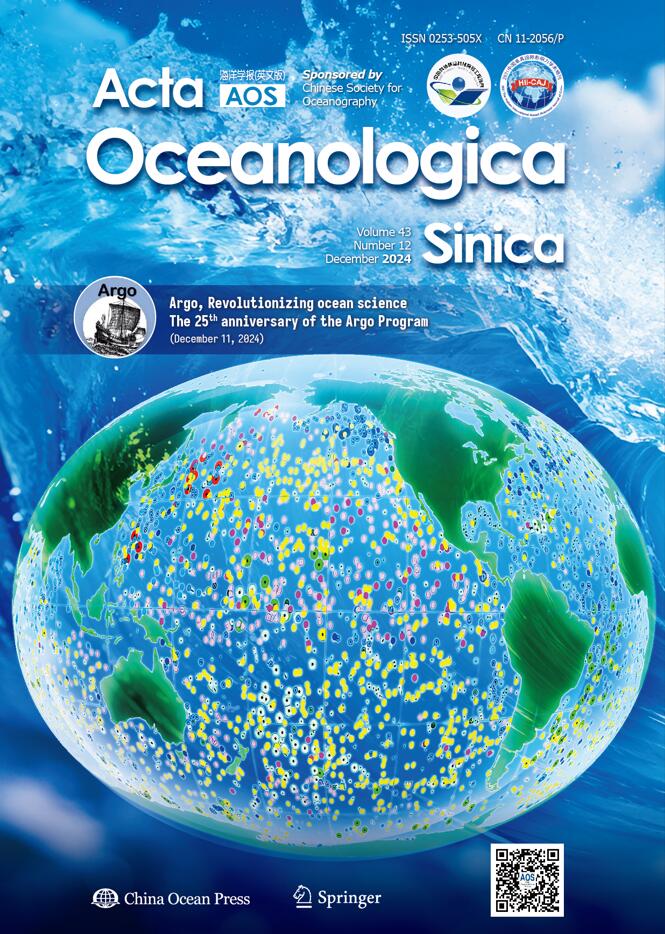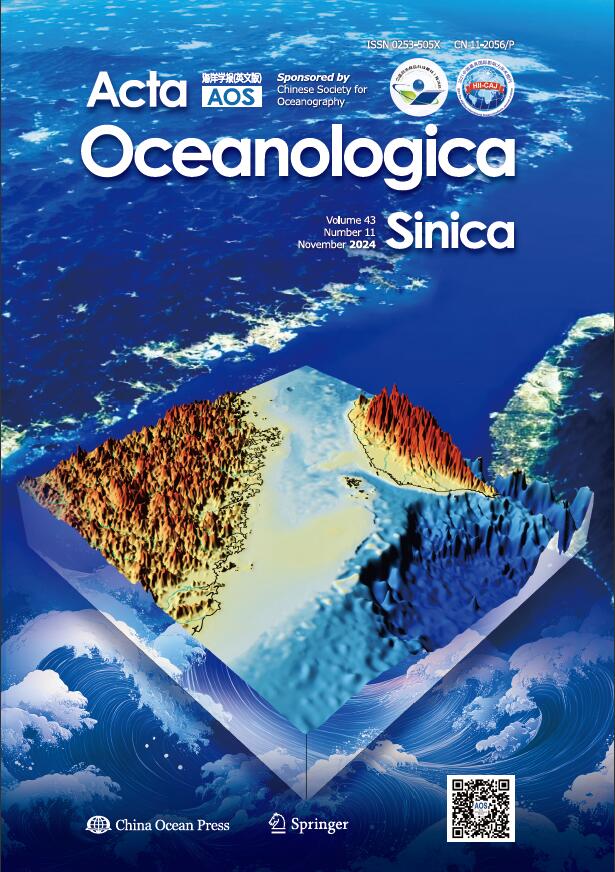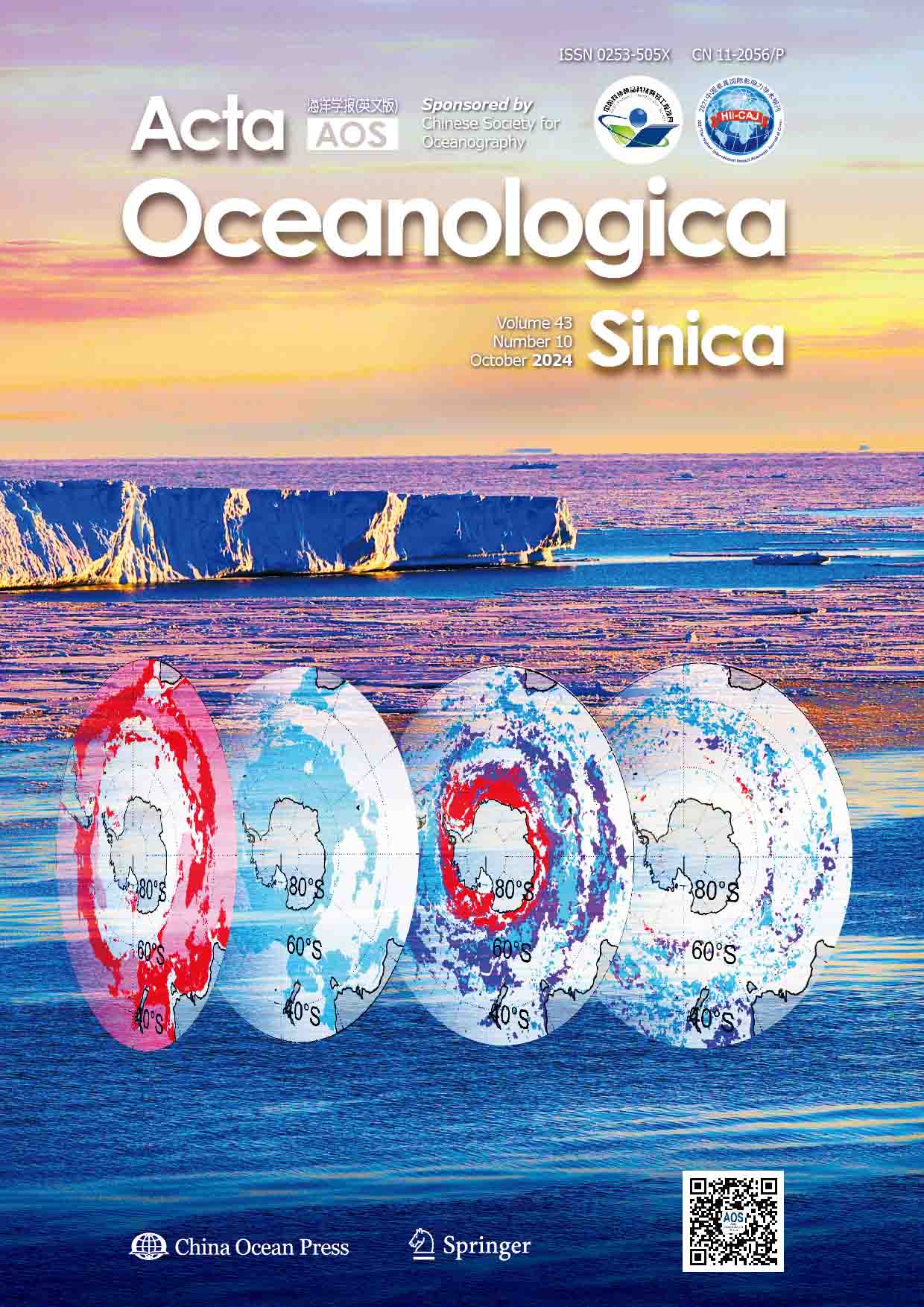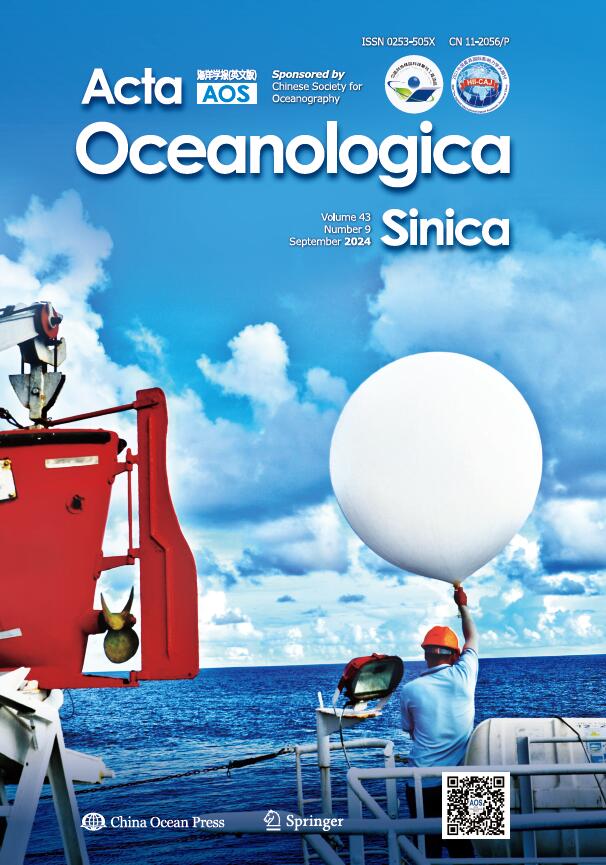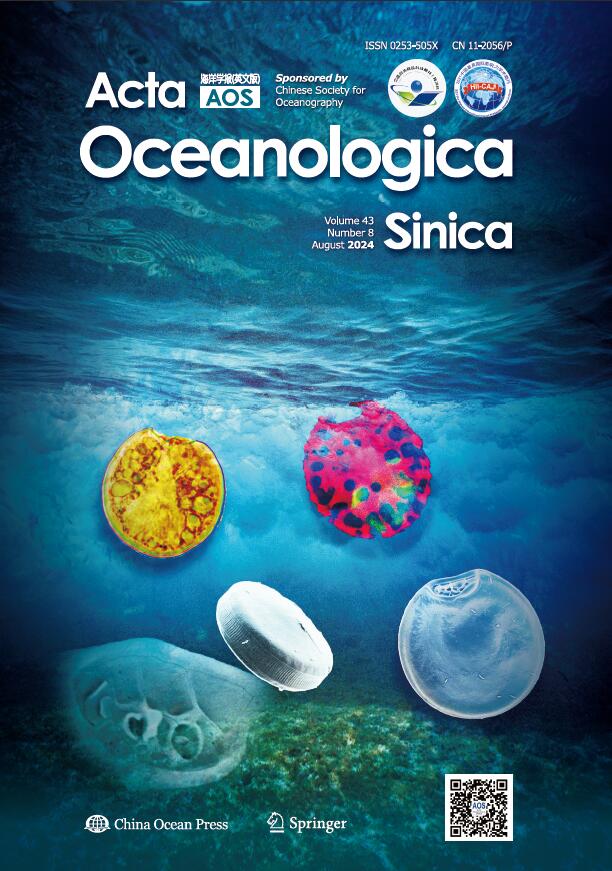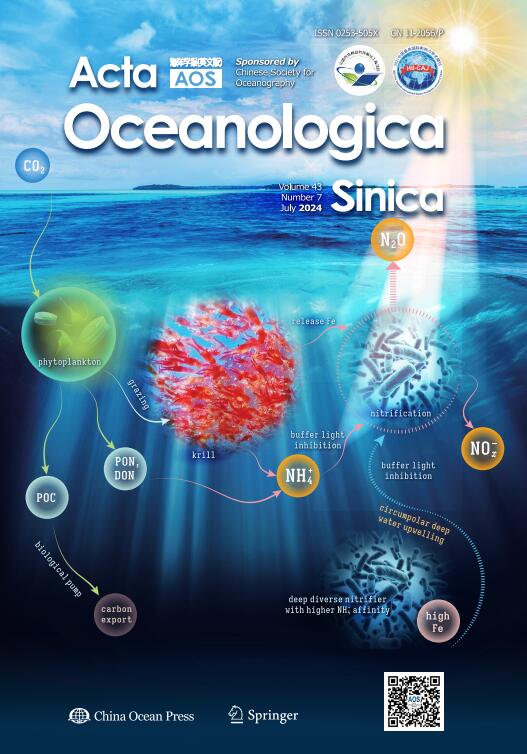2024 Vol. 43, No. 6
Display Method:
2024, 43(6): 1-2.
Abstract:
2024, 43(6): 1-14.
doi: 10.1007/s13131-023-2254-y
Abstract:
Ocean productivity is the foundation of marine food web, which continuously removes atmospheric carbon dioxide and supports life at sea and on land. Spatio-temporal variability of net primary productivity (NPP), sea surface temperature (SST), sea sur...
Ocean productivity is the foundation of marine food web, which continuously removes atmospheric carbon dioxide and supports life at sea and on land. Spatio-temporal variability of net primary productivity (NPP), sea surface temperature (SST), sea sur...
2024, 43(6): 15-31.
doi: 10.1007/s13131-023-2283-6
Abstract:
Highly productive estuaries facilitate intense decomposition of dissolved organic matter (DOM) as a carbon source. However, the specific impacts of typhoons on DOM decomposition in eutrophic bays remain unclear. To address this issue, we investigated...
Highly productive estuaries facilitate intense decomposition of dissolved organic matter (DOM) as a carbon source. However, the specific impacts of typhoons on DOM decomposition in eutrophic bays remain unclear. To address this issue, we investigated...
2024, 43(6): 32-37.
doi: 10.1007/s13131-023-2267-6
Abstract:
Marine sediments collected from the Zhujiang (Pearl) River Estuary (ZRE) and South China Sea (SCS) were utilized to study the occurrence and spatial distribution of tetrabromobisphenol A (TBBPA) and hexabromocyclododecane (HBCDD). The levels of TBBPA...
Marine sediments collected from the Zhujiang (Pearl) River Estuary (ZRE) and South China Sea (SCS) were utilized to study the occurrence and spatial distribution of tetrabromobisphenol A (TBBPA) and hexabromocyclododecane (HBCDD). The levels of TBBPA...
2024, 43(6): 38-48.
doi: 10.1007/s13131-024-2377-9
Abstract:
Zhanjiang Bay is a major aquaculture area in China with many types of mariculture products (such as oysters, fish, and shrimp). The culture area and shrimp output in Zhanjiang Bay are ranked first in China. We investigated the total organic carbon (T...
Zhanjiang Bay is a major aquaculture area in China with many types of mariculture products (such as oysters, fish, and shrimp). The culture area and shrimp output in Zhanjiang Bay are ranked first in China. We investigated the total organic carbon (T...
2024, 43(6): 49-59.
doi: 10.1007/s13131-023-2243-1
Abstract:
Oxygen facilitates the breakdown of the organic material to provide energy for life. The concentration of dissolved oxygen (DO) in the water must exceed a certain threshold to support the normal metabolism of marine organisms. Located in the northern...
Oxygen facilitates the breakdown of the organic material to provide energy for life. The concentration of dissolved oxygen (DO) in the water must exceed a certain threshold to support the normal metabolism of marine organisms. Located in the northern...
2024, 43(6): 60-70.
doi: 10.1007/s13131-024-2373-0
Abstract:
Eutrophication in coastal waters has been increasing remarkably, severely impacting the water quality in mariculture bays. In this study, we conducted multiple isotopic measurements on suspended particulate nitrogen (δ15N-PN) and dissolved nitrate (δ...
Eutrophication in coastal waters has been increasing remarkably, severely impacting the water quality in mariculture bays. In this study, we conducted multiple isotopic measurements on suspended particulate nitrogen (δ15N-PN) and dissolved nitrate (δ...
2024, 43(6): 71-85.
doi: 10.1007/s13131-023-2308-9
Abstract:
Understanding the mechanism of harmful algal bloom formation is vital for effectively preventing algal bloom outbreaks in coastal environments. Karenia spp. blooms in the East China Sea show a significant correlation with nutrient regimes. However, t...
Understanding the mechanism of harmful algal bloom formation is vital for effectively preventing algal bloom outbreaks in coastal environments. Karenia spp. blooms in the East China Sea show a significant correlation with nutrient regimes. However, t...
2024, 43(6): 86-95.
doi: 10.1007/s13131-024-2375-y
Abstract:
Eutrophication caused by inputs of excess nitrogen (N) has become a serious environmental problem in Hangzhou Bay (China), but the sources of this nitrogen are not well understood. In this study, the August 2019 distributions of salinity, nutrients [...
Eutrophication caused by inputs of excess nitrogen (N) has become a serious environmental problem in Hangzhou Bay (China), but the sources of this nitrogen are not well understood. In this study, the August 2019 distributions of salinity, nutrients [...
2024, 43(6): 96-106.
doi: 10.1007/s13131-024-2374-z
Abstract:
Ocean fronts play important roles in nutrient transport and in the shaping ecological patterns. Frontal zones in small bays are typically small in scale, have a complex structure, and they are spatially and temporally variable, but there are limited ...
Ocean fronts play important roles in nutrient transport and in the shaping ecological patterns. Frontal zones in small bays are typically small in scale, have a complex structure, and they are spatially and temporally variable, but there are limited ...
2024, 43(6): 107-118.
doi: 10.1007/s13131-024-2311-1
Abstract:
Massive bodies of low-oxygen bottom waters are found in coastal areas worldwide, which are detrimental to coastal ecosystems. In summer 2020, the response of coastal hypoxia to extreme weather events, including a catastrophic flooding, an extreme mar...
Massive bodies of low-oxygen bottom waters are found in coastal areas worldwide, which are detrimental to coastal ecosystems. In summer 2020, the response of coastal hypoxia to extreme weather events, including a catastrophic flooding, an extreme mar...
2024, 43(6): 119-130.
doi: 10.1007/s13131-023-2244-0
Abstract:
Hypoxia off the Changjiang River Estuary has been the subject of much attention, yet systematic observations have been lacking, resulting in a lack of knowledge regarding its long-term change and drivers. By revisiting the repeated surveys of dissolv...
Hypoxia off the Changjiang River Estuary has been the subject of much attention, yet systematic observations have been lacking, resulting in a lack of knowledge regarding its long-term change and drivers. By revisiting the repeated surveys of dissolv...
2024, 43(6): 131-141.
doi: 10.1007/s13131-024-2376-x
Abstract:
The sinking of phytoplankton is critical to organic matter transportation in the ocean and it is an essential process for the formation of coastal hypoxic zones. This study was based on a field investigation conducted during the summer of 2022 in the...
The sinking of phytoplankton is critical to organic matter transportation in the ocean and it is an essential process for the formation of coastal hypoxic zones. This study was based on a field investigation conducted during the summer of 2022 in the...
2024, 43(6): 142-152.
doi: 10.1007/s13131-024-2372-1
Abstract:
The nutrients from the East China Sea (ECS) through the Tsushima/Korea Strait (TS) strongly impact the ecosystem of the Japan Sea (JS). The complex origins of the Tsushima Warm Current and the various nutrient sources in the ECS result in complex spa...
The nutrients from the East China Sea (ECS) through the Tsushima/Korea Strait (TS) strongly impact the ecosystem of the Japan Sea (JS). The complex origins of the Tsushima Warm Current and the various nutrient sources in the ECS result in complex spa...
2024, 43(6): 153-162.
doi: 10.1007/s13131-023-2245-z
Abstract:
Petroleum hydrocarbon pollution is a global concern, particularly in coastal environments. Polycyclic aromatic hydrocarbons (PAHs) are regarded as the most toxic components of petroleum hydrocarbons. In this study, the biomonitoring and ranking effec...
Petroleum hydrocarbon pollution is a global concern, particularly in coastal environments. Polycyclic aromatic hydrocarbons (PAHs) are regarded as the most toxic components of petroleum hydrocarbons. In this study, the biomonitoring and ranking effec...
2024, 43(6): 163-172.
doi: 10.1007/s13131-024-2309-8
Abstract:
The sinking of diatoms is critical to the formation of oceanic biological pumps and coastal hypoxic zones. However, little is known about the effects of different nutrient restrictions on diatom sinking. In this study, we measured the sinking velocit...
The sinking of diatoms is critical to the formation of oceanic biological pumps and coastal hypoxic zones. However, little is known about the effects of different nutrient restrictions on diatom sinking. In this study, we measured the sinking velocit...



